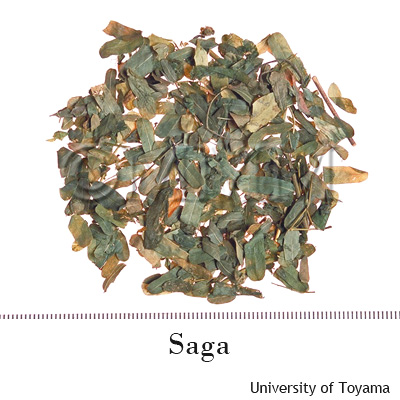Crude drug sample data base
※Click on the image to enlarge it.
The capital city, provincial capital city or the representative
location of its administrative area is indicated.
location of its administrative area is indicated.
Production area information
https://ethmed.toyama-wakan.net/img/pin_san.png
-6.9174639
107.61912280000001
Collection information
Republic of Indonesia,West Java Province
https://ethmed.toyama-wakan.net/img/pin_nyu.png
Scientific information data base
| Crude drug name | Indonesian name, English name | Daun saga, Indian Liquorice | ||||
|---|---|---|---|---|---|---|
| crude drug image |
| |||||
| Original plant name | Abrus precatorius Linn. | |||||
| Family name | Leguminosae | |||||
| Used part | Roots, leaves, seeds | |||||
| Distribution area | It occurs throughout South-East Asia. In Java (Indonesia) it occurs in thickets and as a living fence; but is cultivated now as an ornamental. | |||||
| Description | Leaves are morphologically similar to Tamarind leaves but a little bit thinner; alternate, parripinnate with 16-34 oblong, obovate-oblong or ovate opposite leaflets, obtuse to acuminate at apex; rachis projecting beyond the last pair of leaflets. The plant is a woody climber up to 6 to 9m long. Inflorescence thick and robust, usually curved. Fruit oblong, inflated, 1 to 7 seeded. Seeds ovoid, scarlet with area around hillum black, rarely entirely black, whitish or yellowish. | |||||
| Drug effect | Leaves and root - sweet and neutralizing; seeds - bitter and poisonous. | |||||
| Specific actions | Root: anti-inflammatory and diuretic; leaves: antitussive; seeds: anti-inflammatory and parasiticide [231]. | |||||
| Frequency in use | Moderate. | |||||
| Common uses | The red-coloured seeds are used as beads in necklaces. They have also been used in soldering jewelry; when macerated in water they become mucous and this sticky substance was mixed with solder to distribute it as a temporary cement prior to heating [201, 205]. | |||||
| Side effect | The seeds are extremely poisonous. They contain a toxic lectin fraction called abrin [205]. | |||||
| Pharmacological effect | The roots and leaves are known to contain constituents that have anti-inflammatory, anti-tumour, antitoxic, antitussive, anti-thrombotic and antibiotic properties. The roots are also known to have antioestrogenic activity [205]. Abruquinones A, B, D were found to exhibit remarkable inhibitory effects on platelet aggregation [205]. Abruquinones A, B, D, F showed strong anti-inflammatory and anti-allergic effects [205]. A methanol extract of the seeds showed a concentration-related inhibitory effect on the motility of human spermatozoa and reduce sperm viability [205]. Abruquinone B and a new derivative, abruquinone G were isolated from the aerial parts of Abrus precatorius. The first compound has antitubercular, antiplasmodual and ctytotoxix properties, while the second compound has mild antiviral and cytotoxic activities [PMID:15114511]. Effect of abrin isolated from Abrus precatorius on the cellular immune responses was studied in normal as well as tumor-bearing animals. Results of our present study suggest the immunomodulatory property of abrin [PMID:16451752]. Two triterpenoid saponins were isolated from the aerial parts of Abrus precatorius and their acetates derivatives, and have been tested for anti-inflammatory activity. All the compounds exhibited anti-inflammatory activity but the acetates showed greater inhibition than the parent compounds [PMID:11292235]. | |||||
| Medical system | Indonesian medicine (Jamu) | |||||
| Traditional usage | The leaves are sweet and the decoction is used in the same way as liquorice in treating aphtha (mouth ulcer), tonsillitis and sore throat The decoction which is taken as tea, tastes sweet and nauseating. Decoction of the leaves together with cinnamon is gargled to treat mouth ulcer [201]. Raw seeds are not edible. | |||||
| Formulation | 1) Cough: 1 handful of saga leaves, 5 fennel fruits, bark of Alyxia reinwardtii are mixed and boiled with 110 ml of water. Stand to cool and strain. Drink 100 ml of the decoction once a day for 14 days [231]. | |||||
| References | Reference book Tips! | [201] K. Heyne, Tumbuhan Berguna Indonesia, Vols. 1-4, 1987. Diedarkan Oleh Koperasi Karyawan Departemen Kehutanan, Jakarta, Indonesia. Vol. 2, pp 1014-1015. [205] de Pdua, L.S., Bunyapraphatsara, N. and Lemmens, R.H.M.J. (Editors), 1990. Plant Resources of South-East Asia No. 12 (1). Medicinal and poisonous plants 1. Backhuys Publishers, Leiden, Netherlands. pp 73-77. [231] Soedibyo, Mooryati: Alam Sumber Kesehatan: Manfaat dan Kegunaan (Natural resources for health. Benefits and uses). Balai Pustaka. 1998. p 322. | ||||
| Research paper | 1. Ramnath V, Kuttan G, Kuttan R. Effect of abrin on cell-mediated immune responses in mice. Immunopharmacol Immunotoxicol. 28(2):259-68, 2006. (PMID: 16873094) 2. Limmatvapirat C, Sirisopanaporn S, Kittakoop P. Antitubercular and antiplasmodial constituents of Abrus precatorius. Planta Med. 70(3):276-8, 2004. (PMID: 15114511) 3. Kim NC, Kim DS, Kinghorn AD. New triterpenoids from the leaves of Abrus precatorius. Nat Prod Lett. 16(4):261-6, 2002. (PMID: 12168762) 4. Anam EM. Anti-inflammatory activity of compounds isolated from the aerial parts of Abrus precatorius (Fabaceae). Phytomedicine. 8(1):24-7, 2001. (PMID: 11292235) | |||||
| Remarks | DNA sequence: AF467015 Abrin is one of the two most toxic substances of plant origin known [205]. | |||||
| Last renewal date | 2024/03/04 | |||||




